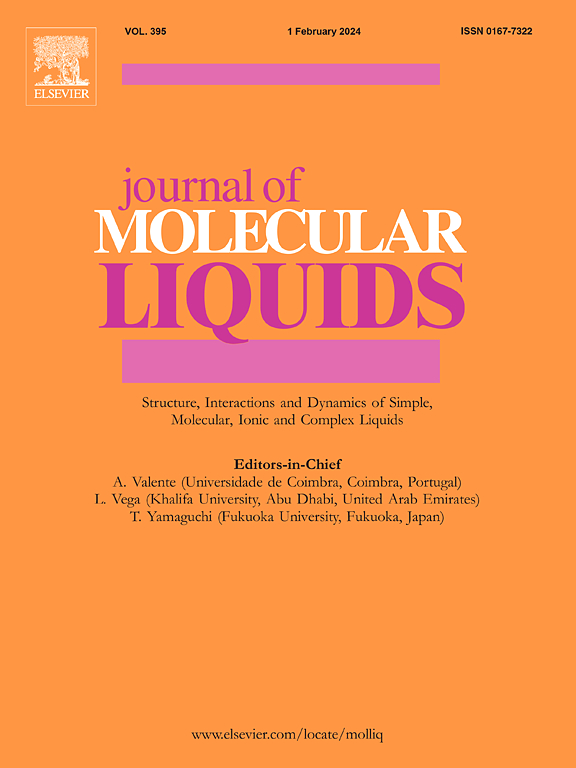Glycerol/lactic acid based natural deep eutectic solvents combined with wet evaporation process for preparing natural rubber composites with low VOCs
IF 5.3
2区 化学
Q2 CHEMISTRY, PHYSICAL
引用次数: 0
Abstract
In this paper, two natural deep eutectic solvents (NADES) were prepared by using natural components glycerol and lactic acid as bio-based hydrogen bonding donors, and the effects of two NADES combined with evaporation technology on silica/natural rubber latex wet masterbatch were investigated. The results showed that NADES successfully coated the silica surface and formed hydrogen bonding interactions with silica, and NADES improved the filler dispersion and filler-rubber interaction force. The compounds prepared by dry mixing with lactic acid-based NADES (LADES) had better processing safety and dynamic mechanical properties than glycerol-based NADES (GLDES). The “Devil's Triangle” of composites containing 3 phr LADES by dry mixing was the largest, with 45 % lower rolling resistance, 25 % higher abrasion resistance and only 7 % lower wet skid resistance compared with NR without NADES. Moreover, the replacement of 2 phr Si69 by NADES in combination with wet evaporation process effectively improved the flowability, processing safety, vulcanization rate and overall mechanical properties, with tensile strengths of 29.85 MPa and 30.49 MPa for GLDES/NR and LADES/NR, respectively. The new NADESs combined with the wet evaporation process are beneficial to replace traditional silane coupling agents and strengthen the interface between NR and Silica.
甘油/乳酸基天然深共晶溶剂结合湿蒸发工艺制备低VOCs天然橡胶复合材料
本文以天然组分甘油和乳酸为生物基氢键给体制备了两种天然深共晶溶剂(NADES),并研究了两种NADES结合蒸发技术对二氧化硅/天然胶乳湿母粒的影响。结果表明,NADES成功地包覆了二氧化硅表面,并与二氧化硅形成了氢键相互作用,提高了填料的分散性和填料与橡胶的相互作用力。乳酸基NADES (LADES)与甘油基NADES (GLDES)干混制备的复合物具有更好的加工安全性和动态力学性能。与不含NADES的NR相比,含有3phr NADES的复合材料的“魔鬼三角”性能最大,其滚动阻力降低45%,耐磨性提高25%,湿滑阻力仅降低7%。此外,NADES与湿蒸发工艺相结合替代2 phr Si69,有效提高了GLDES/NR的流动性、加工安全性、硫化率和整体力学性能,GLDES/NR和LADES/NR的抗拉强度分别达到29.85 MPa和30.49 MPa。新型NADESs与湿蒸发工艺相结合,有利于取代传统的硅烷偶联剂,增强NR与二氧化硅之间的界面。
本文章由计算机程序翻译,如有差异,请以英文原文为准。
求助全文
约1分钟内获得全文
求助全文
来源期刊

Journal of Molecular Liquids
化学-物理:原子、分子和化学物理
CiteScore
10.30
自引率
16.70%
发文量
2597
审稿时长
78 days
期刊介绍:
The journal includes papers in the following areas:
– Simple organic liquids and mixtures
– Ionic liquids
– Surfactant solutions (including micelles and vesicles) and liquid interfaces
– Colloidal solutions and nanoparticles
– Thermotropic and lyotropic liquid crystals
– Ferrofluids
– Water, aqueous solutions and other hydrogen-bonded liquids
– Lubricants, polymer solutions and melts
– Molten metals and salts
– Phase transitions and critical phenomena in liquids and confined fluids
– Self assembly in complex liquids.– Biomolecules in solution
The emphasis is on the molecular (or microscopic) understanding of particular liquids or liquid systems, especially concerning structure, dynamics and intermolecular forces. The experimental techniques used may include:
– Conventional spectroscopy (mid-IR and far-IR, Raman, NMR, etc.)
– Non-linear optics and time resolved spectroscopy (psec, fsec, asec, ISRS, etc.)
– Light scattering (Rayleigh, Brillouin, PCS, etc.)
– Dielectric relaxation
– X-ray and neutron scattering and diffraction.
Experimental studies, computer simulations (MD or MC) and analytical theory will be considered for publication; papers just reporting experimental results that do not contribute to the understanding of the fundamentals of molecular and ionic liquids will not be accepted. Only papers of a non-routine nature and advancing the field will be considered for publication.
 求助内容:
求助内容: 应助结果提醒方式:
应助结果提醒方式:


